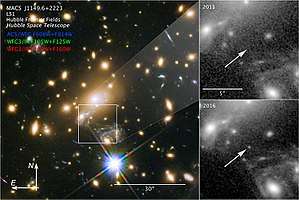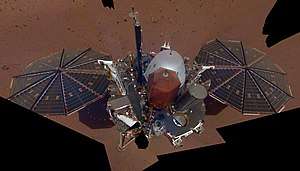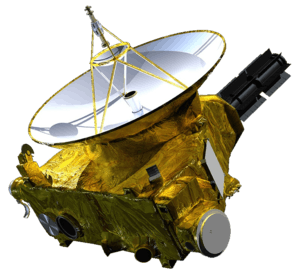486958 Arrokoth
486958 Arrokoth,[lower-alpha 2] provisional designation 2014 MU69, is a trans-Neptunian object located in the Kuiper belt. It is a contact binary 36 km (22 mi) long, composed of two planetesimals 21 km (13 mi) and 15 km (9 mi) across, nicknamed "Ultima" and "Thule", respectively, that are joined along their major axes. Ultima, which is flatter than Thule, appears to be an aggregate of 8 or so smaller units, each approximately 5 km (3 mi) across, that fused together before Ultima and Thule came into contact. Because there have been few to no disruptive impacts on Arrokoth since it formed, the details of its formation have been preserved. With the New Horizons space probe's flyby at 05:33 on 1 January 2019 (UTC time), Arrokoth became the farthest and most primitive object in the Solar System visited by a spacecraft.[17][18][19] At the time of the New Horizons flyby, the object had been nicknamed Ultima Thule.[lower-alpha 3]
.png) Color composite image of Arrokoth[1][lower-alpha 1] | |||||||||
| Discovery [4][5] | |||||||||
|---|---|---|---|---|---|---|---|---|---|
| Discovered by | Marc W. Buie New Horizons KBO Search | ||||||||
| Discovery site | Hubble Space Telescope | ||||||||
| Discovery date | 26 June 2014 | ||||||||
| Designations | |||||||||
| (486958) Arrokoth | |||||||||
| Pronunciation | /ˈærəkɒθ/ | ||||||||
Named after | Arrokoth (Powhatan word glossed "sky" but probably meaning "cloud") | ||||||||
| (486958) 2014 MU69 Ultima Thule (unofficial)[6] | |||||||||
| Orbital characteristics[5][8] | |||||||||
| Epoch 27 April 2019 (JD 2458600.5) | |||||||||
| Uncertainty parameter 2 | |||||||||
| Observation arc | 2.33 yr (851 days) | ||||||||
| Aphelion | 46.442 AU | ||||||||
| Perihelion | 42.721 AU | ||||||||
| 44.581 AU | |||||||||
| Eccentricity | 0.04172 | ||||||||
| 297.67 yr | |||||||||
| 316.551° | |||||||||
| 0° 0m 11.92s / day | |||||||||
| Inclination | 2.4512° | ||||||||
| 158.998° | |||||||||
| 174.418° | |||||||||
| Physical characteristics | |||||||||
| Dimensions | 36 × 20 × 10 km (overall best fit)[9] Ultima 20.6 × 19.9 × 9.4 km[10] Thule 15.4 × 13.8 × 9.8 km[10] | ||||||||
Mean diameter | 18.3±1.2 km (volume equivalent)[10] Ultima 15.9 km[10] Thule 12.9 km[10] | ||||||||
| Volume | 3210±650 km3[10] | ||||||||
Equatorial surface gravity | ~ 0.0001 g ~ 0.001 m/s2[11] | ||||||||
| 15.9380±0.0005 h[12] | |||||||||
| 99.3°[13] | |||||||||
North pole right ascension | 317.5°±1°[9] | ||||||||
North pole declination | −24.89°±1°[9][13] | ||||||||
| 0.21+0.05 −0.04 (geometric)[14] 0.062±0.015 (Bond)[14] | |||||||||
| |||||||||
| V−I=1.35[15] G−I=1.42±0.14[16] G−R=0.95±0.14[16] | |||||||||
| 26.6[15] | |||||||||
| 11.1[4][5] | |||||||||
Arrokoth was discovered on 26 June 2014 by astronomer Marc Buie and the New Horizons Search Team using the Hubble Space Telescope as part of a search for a Kuiper belt object for the New Horizons mission to target in its first extended mission; it was chosen over two other candidates to become the primary target of the mission.[23] With an orbital period of about 298 years and a low orbital inclination and eccentricity, Arrokoth is classified as a cold classical Kuiper belt object.
Nomenclature
Name
Arrokoth was named for a word in the Powhatan language of the Tidewater region of Virginia and Maryland.[24] The Powhatan language became extinct in the late 18th century and little was recorded of it. In an old word list, arrokoth is glossed as 'sky', but it is more likely that it meant 'cloud'.[lower-alpha 4]
.jpg)
Arrokoth's name was chosen by the New Horizons team to represent the Powhatan people indigenous to the Tidewater region that includes the state of Maryland, where Arrokoth's discovery took place.[24] The Hubble Space Telescope and Johns Hopkins Applied Physics Laboratory were both operated at Maryland and were prominently involved in Arrokoth's discovery.[24][26] With the permission of the elders of the Pamunkey Native American Tribe, the name Arrokoth was proposed to the International Astronomical Union (IAU) and was announced by the New Horizons team in a ceremony held at the NASA Headquarters in the District of Columbia on 12 November 2019.[24] During the ceremony, New Horizons principal investigator Alan Stern explained the choice of the name, stating:
The name 'Arrokoth' reflects the inspiration of looking to the skies, and wondering about the stars and worlds beyond our own. That desire to learn is at the heart of the New Horizons mission, and we're honored to join with the Powhatan community and people of Maryland in this celebration of discovery.[24]
In acknowledgement to the Powhatan people's significance to the Tidewater region of Virginia and Maryland, Lori Glaze, director of NASA's Planetary Science Division, asserted that Arrokoth's name "signifies the strength and endurance of the indigenous Algonquian people" and that their heritage "continues to be a guiding light for all who search for meaning and understanding of the origins of the universe and the celestial connection of humanity."[24] Prior to the ceremony, the name was accepted by the IAU's Minor Planet Center on 8 November 2019 and the New Horizons team's naming citation was published in a Minor Planet Circular on 12 November 2019.[26]
Nickname and designation
When Arrokoth was first observed, it was labelled 1110113Y in the context of the Hubble Space Telescope's search for Kuiper belt objects,[27] and was nicknamed "11" for short.[28][29] Its existence as a potential target of the New Horizons probe was announced by NASA in October 2014[30][31] and it was unofficially designated as "Potential Target 1", or PT1.[29] Its official designation, 2014 MU69, was assigned by the Minor Planet Center in March 2015, after sufficient orbital information was gathered.[29] The provisional designation indicates that Arrokoth was the 1745th minor planet discovered during the second half of June 2014.[lower-alpha 5] After further observations refining its orbit, it was given the permanent minor planet number 486958 on 12 March 2017.[33]
Before the flyby on 1 January 2019, NASA invited suggestions from the public on a nickname to be used.[34] The campaign involved 115,000 participants from around the world, who suggested some 34,000 names. Of those, 37 reached the ballot for voting and were evaluated for popularity – this included 8 names suggested by the New Horizons team and 29 suggested by the public. Ultima Thule,[lower-alpha 3] which was selected on 13 March 2018,[6] was proposed by about 40 different members of the public and obtained the seventh highest number of votes among the nominees.[35] Thoúlē, Latin: Thūlē) is the farthest north location mentioned in ancient Greek and Roman literature and cartography, while in classical and medieval literature, ultima Thule (Latin, "farthermost Thule") acquired a metaphorical meaning of any distant place located beyond the "borders of the known world".[36][6] Once it was determined the body was a bilobate contact binary object, the New Horizons team nicknamed the larger lobe "Ultima" and the smaller "Thule".[37]
The nickname was criticized due to its use by 19th century racists as the mythical homeland of the Aryan race, a belief which was later adopted by Nazi occultists including the Thule society, which was a key sponsor of what became the Nazi Party. The phrase is used by some modern-day neo-Nazis and members of the alt-right.[38] In more recent times it was used to refer to the historical Inuit culture of the Thule people.[39]
A few members of the New Horizons team were aware of that association when they selected the nickname, and have since defended their choice. Responding to a question at a press conference, Alan Stern said, "Just because some bad guys once liked that term, we're not going to let them hijack it."[40]
Shape
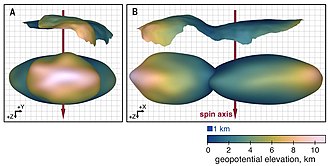
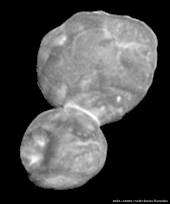
Arrokoth is a contact binary consisting of two lobes attached by a bright, narrow neck.[37] The two lobes were likely once two objects that had merged in a slow collision.[41] The larger lobe, nicknamed Ultima, is measured at about 21.6 km (13.4 mi) across its longest axis[42] while the smaller lobe, Thule, is measured at 15.4 km (9.6 mi) across its longest axis.[43] The larger lobe is lenticular in shape, being highly flattened and moderately elongated.[42] Based on shape models of Arrokoth constructed from images taken by the New Horizons spacecraft, the dimensions of the larger lobe are approximately 21 km × 20 km × 9 km (13.0 mi × 12.4 mi × 5.6 mi). In contrast, the smaller lobe is less flattened, with dimensions of 15 km × 14 km × 10 km (9.3 mi × 8.7 mi × 6.2 mi). As a whole, Arrokoth is 36 km (22 mi) across its longest axis and is about 10 km (6.2 mi) thick, with the centers of lobes separated from each other by 17.2 km (10.7 mi).[9][10]
Given the volume equivalent lobe diameters of 15.9 km (9.9 mi) and 12.9 km (8.0 mi), the volume ratio of the larger lobe to the smaller lobe is approximately 1.9:1.0, meaning that the larger lobe's volume is nearly twice as large as the smaller lobe's volume. Overall, the volume of Arrokoth is around 3,210 km3 (770 cu mi), though this estimate is largely uncertain due to weak constraints on the thicknesses of the lobes.[10]
Prior to the New Horizons flyby of Arrokoth, stellar occultations by Arrokoth had provided evidence for its bilobate shape.[44] The first detailed image of Arrokoth confirmed its double-lobed appearance and was described as a "snowman" by Alan Stern, as the two lobes appeared distinctively spherical.[45] On 8 February 2019, one month after the New Horizons flyby, Arrokoth was found to be more flattened than initially thought, based on additional images of Arrokoth taken by New Horizons after its closest approach. The flattened larger lobe of Arrokoth was described as a "pancake", while the smaller lobe was described as a "walnut" as it appeared less flattened compared to the larger lobe. By observing how the unseen sections of Arrokoth occulted background stars, scientists were able to then outline the shapes of both lobes.[46] The cause of Arrokoth's unexpectedly flattened shape is uncertain, though one possibility is that the two separate lobes were once rotating rapidly, causing them to become flattened due to centrifugal forces.[47][48]
The longest axes of the two lobes are nearly aligned toward their rotational axis, which is situated between the two lobes.[42] This near-parallel alignment of the two lobes suggests that they were mutually locked to each other, likely due to tidal forces, before merging.[42] The alignment of the two lobes supports the idea that the two had individually formed from the coalescence of a cloud of icy particles.[49]
Geology
Spectra and surface
.png)

.png)
Measurements of Arrokoth's absorption spectrum by the New Horizons' LEISA spectrometer show that Arrokoth's spectrum exhibits a strong red spectral slope extending from red to infrared wavelengths at 1.2–2.5 μm.[42] Spectral measurements from LEISA have revealed the presence of methanol, hydrogen cyanide, water ice, and organic compounds on the surface of Arrokoth.[50][51] An unidentified absorption band was also found in Arrokoth's spectrum at 1.8 μm.[42] Arrokoth's spectrum shares similarities with that of 2002 VE95 and the centaur 5145 Pholus, which both also display strong red spectral slopes along with signs of methanol present on their surfaces.[42]
Preliminary observations with the Hubble Space Telescope in 2016 revealed that Arrokoth has a red coloration, similar to other Kuiper belt objects and centaurs like Pholus.[52][42] Arrokoth's color is redder than that of Pluto, thus it belongs to the "ultra red" population of cold classical Kuiper belt objects.[53][54] The red coloration of Arrokoth is caused by the presence of a mix of complex organic compounds called tholins on Arrokoth's surface. The tholins are thought to have been produced from the photolysis of simple organic compounds and volatiles irradiated by cosmic rays and ultraviolet solar radiation. The presence of tholins on Arrokoth's surface implies that volatiles such as methane and ammonia may be present on Arrokoth, although they would be lost on short timescales as Arrokoth is far too small to be able to retain these materials.[55] However, less volatile materials such as methanol, acetylene, ethane, and hydrogen cyanide could be retained over a longer period of time, and may likely account for the reddening and production of tholins on Arrokoth.[42] The photoionization of organic compounds and volatiles on Arrokoth is expected to also produce hydrogen gas, which would escape and interact with solar wind, though the New Horizons' SWAP and PEPSSI instruments did not detect any signature of solar wind interaction around Arrokoth.[42]
From color and spectral measurements of Arrokoth, the surface displays subtle color variation among its surface features.[50] Spectral images of Arrokoth show that the neck region and lineation features appear less red while the central region of the smaller lobe appears more red.[11] The larger lobe also displays redder regions, which were informally known as "thumbprints" by the New Horizons team. The thumbprints are located near the larger lobe's limb.[11] The surface albedo or reflectivity of Arrokoth varies from 5 percent to 12 percent due to various bright features on its surface.[42] Its overall geometric albedo, the quantity of reflected light in visible spectrum, is measured at 21 percent, typical for most Kuiper belt objects.[14] The overall Bond albedo (the quantity of reflected light of any wavelength) of Arrokoth is measured at 6.3 percent.[14]
Craters
The surface of Arrokoth is lightly cratered and smooth in appearance.[9] Arrokoth's surface lacks small impact craters less than 1 km (0.62 mi) in size, implying a lack of impacts throughout its history.[56] The occurrence of impact events in the Kuiper belt is thought to be uncommon, with a very low impact rate over the course of one billion years.[57] Due to the slower orbital speeds of Kuiper belt objects, the speed of objects impacting Arrokoth is expected to be low, with typical impact speeds around 300 m/s (980 ft/s).[57] At such slow impact speeds, large craters on Arrokoth are expected to be rare. With a low frequency of impact events along with the slow speeds of impacts, Arrokoth's surface would remain preserved since its formation. The preserved surface of Arrokoth could possibly give hints to its formation process, as well as signs of accreted material.[57][37]
Numerous small pits on Arrokoth's surface were identified in high resolution images from the New Horizons spacecraft.[58][2] The size of these pits are measured at about 700 m (2,300 ft) across.[58] The exact cause of these pits is unknown; several explanations for these pits include impact events, the collapse of material, the sublimation of volatile materials, or the venting and escape of volatile gases from the interior of Arrokoth.[58][2]
Surface features
The surfaces of each lobe of Arrokoth display regions of varying brightness along with various geological features such as troughs and hills.[42][59] These geological features are thought to have originated from the clumping of smaller planetesimals that come to form the lobes of Arrokoth.[43] The brighter regions of Arrokoth’s surface, especially its bright lineation features, are thought to have resulted from the deposition of material that have rolled down from hills on Arrokoth,[53] as surface gravity on Arrokoth is sufficient for this to occur.[11]
The smaller ‘Thule’ lobe of Arrokoth bears a large depression feature informally named ‘Maryland’ by the New Horizons team, after the eponymous state where the Johns Hopkins University Applied Physics Laboratory is located and operated.[53] Assuming the large depression feature has a circular shape, the diameter is 6.7 km (4.2 mi) across, with a depth of 0.51 km (0.32 mi).[9] The depression is likely an impact crater that was formed by an object 700 m (2,300 ft) in size.[60] Two bright streaks of similar size are notably present in the depression feature, and may be associated with avalanches where bright material rolls down into the depression.[42] Four subparallel troughs are present near the terminator of the small lobe, along with two possible kilometer-sized impact craters on the rim of the large depression feature.[59][42] The surface of the small lobe exhibits bright mottled regions separated by broad, dark regions (labeled dm in the right image) which may have undergone scarp retreat, in which they were eroded due to the sublimation of volatiles, exposing lag deposits of darker material irradiated by sunlight.[59] Another bright region (labeled rm in the right image), located at the equatorial end of the small lobe, exhibits rough terrain along with several topographic features that have been identified as possible pits, craters, or mounds.[42] Unlike the larger lobe, the small lobe does not appear to display distinct subunits of rolling topography, likely as a result of resurfacing caused by the same impact event that created the large depression feature of the small lobe.[42]
Like the smaller lobe, troughs and pit crater chains are also present along the terminator of the larger lobe of Arrokoth, nicknamed ‘Ultima’. The larger lobe consists of eight smaller subunits of rolling topography, each similarly sized at around 5 km (3.1 mi).[42] Each distinctive subunit appears to be separated by relatively bright boundary regions.[42] The similar sizes of the subunits of the large lobe suggests that each subunit was an individual small planetesimal, which eventually coalesced with other small planetesimals to form the large lobe of Arrokoth.[42] These planetesimal units are expected to have accreted very slowly (at speeds of several meters per second), though they must have a very low mechanical strength in order to merge and form compact bodies at these speeds.[42] The central subunit of the large lobe bears a bright ring-shaped feature informally called ‘The Road to Nowhere’.[2][11] From stereographic analysis, the central feature appears to be relatively flat compared to other topography units of the large lobe.[42] Stereographic analysis of Arrokoth has also shown that one particular subunit located at the large lobe's limb (labeled md in the right image) appears to have a higher elevation and tilt compared to other subunits.[42]
The neck region connecting both lobes of Arrokoth has a brighter and less red appearance compared to the surfaces of both lobes.[61] The brighter region in the neck is likely composed of a more reflective material different from the surfaces of Arrokoth’s lobes. One hypothesis suggests the bright material in the neck region had likely originated from the deposition of small particles that had fallen from Arrokoth’s lobes over time.[62] Since Arrokoth’s center of gravity lies between the two lobes, small particles are likely to roll down the steep slopes toward the center between each lobe.[61] Another proposal suggests the bright material is produced by the deposition of ammonia ice.[63] Ammonia vapor present on the surface of Arrokoth would solidify around the neck region, where gases cannot escape due to the concave shape of the neck.[63] Arrokoth’s neck region is also thought to be maintained by seasonal changes as it orbits around the Sun, due to its high axial tilt.[64] Over the course of its orbit, the neck region of Arrokoth is shadowed when its lobes are coplanar to the direction of the Sun, in which the neck region no longer receives sunlight, cooling down and trapping volatiles in the region.[64]
Internal structure
Topography variations at the limb of Arrokoth suggest that its interior is likely composed of mechanically strong material consisting of mostly amorphous water ice and rocky material.[62][65] Trace amounts of methane and other volatile gases in the form of vapors may be also present in Arrokoth's interior, trapped in water ice.[65] Under the assumption that Arrokoth has a low comet-like density of around 0.5 g/cm3, its internal structure is expected to be porous, as volatile gases trapped in Arrokoth's interior are thought to escape from the interior to the surface.[42][65] Assuming that Arrokoth may have an internal heat source caused by the radioactive decay of radionuclides, the trapped volatile gases inside Arrokoth would migrate outward and escape from the surface, similarly to the scenario of outgassing of comets.[65] The escaped gases may subsequently freeze and deposit on Arrokoth's surface, and could possibly account for the presence of ices and tholins on its surface.[65][55]
Orbit and classification
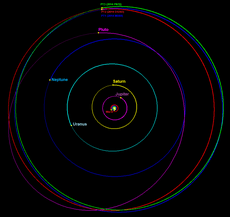

New Horizons · 486958 Arrokoth · Earth · 132524 APL · Jupiter · Pluto
Arrokoth orbits the Sun at an average distance of 44.6 astronomical units (6.67×109 km; 4.15×109 mi), taking 297.7 years to complete a full orbit around the Sun. Having a low orbital eccentricity of 0.042, Arrokoth follows a nearly circular orbit around the Sun, only slightly varying in distance from 43.7 AU at perihelion to 46.4 AU at aphelion.[8][5] Because Arrokoth has a low orbital eccentricity, it does not approach close to Neptune such that its orbit can become perturbed under the gravitational influence of Neptune. Arrokoth's minimum orbital intersection distance from Neptune is 12.75 AU—over the course of its orbit, Arrokoth does not approach Neptune within this distance as it is not locked in a mean-motion orbital resonance with Neptune.[5] Being unperturbed by Neptune, Arrokoth's orbit appears to be stable over the long term; simulations by the Deep Ecliptic Survey show that Arrokoth's orbit will not significantly change over the next 10 million years.[7]
At the time of the New Horizons flyby in January 2019, Arrokoth's distance from the Sun was 43.28 AU (6.47×109 km; 4.02×109 mi).[66] At this distance, light from the Sun takes over six hours to reach Arrokoth.[67][68] Arrokoth has last passed aphelion around 1906 and is currently approaching the Sun at a rate of approximately 0.13 AU per year, or about 0.6 kilometers per second (1,300 mph).[66] Arrokoth will approach perihelion by 2055.[5]
Having an observation arc of 851 days, Arrokoth's orbit is fairly well-determined, with an uncertainty parameter of 2 according to the Minor Planet Center.[5] Hubble Space Telescope observations in May and July 2015 as well as in July and October 2016 have greatly reduced the uncertainties in Arrokoth's orbit, which prompted the Minor Planet Center to assign its permanent minor planet number.[69][33] In contrast to the orbit calculated by the Minor Planet Center, Arrokoth's observation arc in the JPL Small-Body Database does not include these additional observations and purports the orbit to be highly uncertain, with an uncertainty parameter of 5.[4][lower-alpha 7]
Arrokoth is generally classified as a distant minor planet or trans-Neptunian object by the Minor Planet Center since it orbits in the outer solar system beyond Neptune.[5][4] Having a non-resonant orbit within the Kuiper belt region 39.5–48 AU from the Sun, Arrokoth is formally classified as a classical Kuiper belt object, or cubewano.[70][71] Arrokoth's orbit is inclined to the ecliptic plane by 2.45 degrees, relatively low compared to other classical Kuiper belt objects such as Makemake.[72] Since Arrokoth has a low orbital inclination and eccentricity, it is part of the dynamically cold population of classical Kuiper belt objects, which are unlikely to have undergone significant perturbations by Neptune during its outward migration in the past. The cold classical population of Kuiper belt objects are thought to be remnant planetesimals left over from the accretion of material during the formation of the Solar System.[70][73]
Rotation and temperature
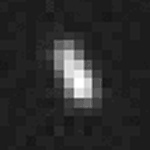
.gif)
Results from photometric Hubble Space Telescope observations show that the brightness of Arrokoth varies by around 0.3 magnitudes as it rotates.[74][75] Though the rotation period and light curve amplitude of Arrokoth could not be determined from Hubble observations, the subtle brightness variations suggests that Arrokoth's rotational axis is either pointed toward the Earth or is being viewed at an equator-on configuration with a nearly spherical shape, with a constrained a/b best-fit aspect ratio around 1.0–1.15.[75][74]
Upon the New Horizons spacecraft's approach to Arrokoth, no rotational light curve amplitude was detected by the spacecraft despite Arrokoth's irregular shape.[76] To explain the lack of its rotational light curve, scientists surmised that Arrokoth is rotating on its side, with its rotational axis pointing nearly directly at the approaching New Horizons spacecraft.[76] Subsequent images of Arrokoth from New Horizons upon approach confirmed that its rotation is tilted, with its south pole facing towards the Sun.[17][19] The rotational axis of Arrokoth is tilted 99 degrees to its orbit.[13] Based on occultation and New Horizons imaging data, Arrokoth's rotation period is determined to be 15.938 hours.[12]
Due to the high axial tilt of its rotation, the solar irradiance of the northern and southern hemispheres of Arrokoth varies greatly over the course of its orbit around the Sun.[42] As it orbits around the Sun, one polar region of Arrokoth faces the Sun continuously while the other faces away. The solar irradiance of Arrokoth varies by 17 percent due to the low eccentricity of its orbit.[42] The average temperature of Arrokoth is estimated to be around 42 K (−231.2 °C; −384.1 °F), with a maximum of around 60 K on the illuminated subsolar point of Arrokoth.[77][50] Radiometric measurements from the New Horizons REX instrument indicate that the mean surface temperature of Arrokoth's unilluminated face is about 29±5 K,[50] higher than the modeled range of 12–14 K. The higher temperature of Arrokoth's unilluminated face as measured by REX implies that thermal radiation is emitted from Arrokoth's subsurface, which was predicted to be intrinsically warmer than the exterior surface.[50]
Mass and density
The mass and density of Arrokoth is unknown. A definitive mass and density estimate cannot be given as the two lobes of Arrokoth are in contact rather than orbiting each other.[78] Although a possible natural satellite orbiting Arrokoth could help determine its mass,[61] no satellites were found orbiting Arrokoth.[78] Under the assumption that both lobes of Arrokoth are bound by self-gravity, with the mutual gravity of the two lobes overcoming centrifugal forces that would otherwise separate the lobes, the entire body is estimated to have a very low density similar to that of comets, with an estimated minimum density of 0.29 g/cm3. In order to maintain the neck region's shape, the density of Arrokoth must be less than the maximum possible density of 1 g/cm3, otherwise the neck region would be excessively compressed by the mutual gravity of the two lobes such that the entire object would gravitationally collapse into a spheroid.[42][79]
Formation
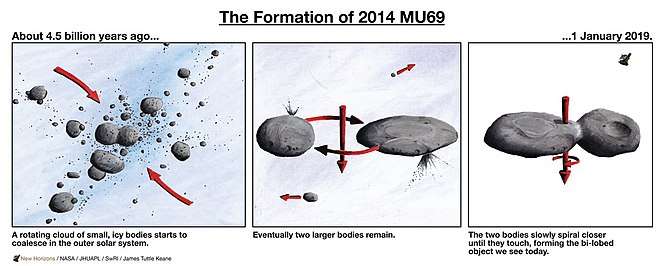
Arrokoth is thought to have originally been two objects, nicknamed "Ultima" and "Thule", that formed over time from a rotating cloud of small, icy bodies since the formation of the Solar System 4.6 billion years ago.[41][53] Icy particles experienced streaming instability, in which they slowed down due to drag against the surrounding gas and dust, and gravitationally coalesced into clumps of larger particles.[78] Based on the differing appearances of the two lobes, each was likely an individual object that accreted separately and remained in a mutual orbit around the other after its formation.[53][80] Both objects are believed to have formed from a single source of material as they appear to be homogeneous in albedo, color, and composition.[42] The presence of rolling topography units on the larger object, Ultima, indicates that it had likely formed from the coalescence of smaller planetesimal units prior to merging with Thule.[80][42]
Although it is unclear how the two constituents of Arrokoth became flattened during its formation, the New Horizons team suggests that the two objects were rotating rapidly, causing their shapes to become flattened due to centrifugal forces. Over time, the rotation rates of the two objects gradually slowed down as they experienced impacts by small objects and transferred their angular momentum to other orbiting debris left over from their formation.[81] Eventually, loss of momentum, caused by impacts and momentum shifting to other bodies in the cloud, caused the pair to slowly spiral closer until they touched—where over time the joints fused together, forming its present bilobate shape.[41][81] The present appearance of Arrokoth does not indicate deformation or compression fractures, suggesting that the two objects had merged very slowly at a speed of 2 m/s (6.6 ft/s)—comparable to the average walking speed of a person.[42][80] There is a possible indication of shearing of the surface and terrain caused by the merging of the two objects.[53]
The frequency of impact events occurring on Arrokoth over a period of at least four billion years was low due to the slower speeds of objects in the Kuiper Belt.[57] At such timescales since its formation, the effect of photon-induced sputtering of water ice on the surface of Arrokoth is estimated to be minimal; over a period of 4.5 billion years, the amount of water ice lost by sputtering would reduce the size of Arrokoth by 1 cm (0.39 in).[42] With the lack of frequent cratering events and perturbations of its orbit, the shape and appearance of Arrokoth would remain virtually pristine since the conjoining of two separate objects that formed its bilobate shape.[57][18]
Observation
Discovery

Arrokoth was discovered on 26 June 2014 using the Hubble Space Telescope during a preliminary survey to find a suitable Kuiper belt object for the New Horizons spacecraft to fly by. Scientists of the New Horizons team were searching for an object in the Kuiper belt that the spacecraft could study after Pluto, and their next target had to be reachable on New Horizons' remaining fuel.[82][73] Using large ground-based telescopes on Earth, researchers began looking in 2011 for candidate objects and searched multiple times per year for several years.[83] However, none of the objects found were reachable by the New Horizons spacecraft and most Kuiper belt objects that may be suitable were just too distant and faint to be seen through Earth's atmosphere.[82][83] In order to find these fainter Kuiper belt objects, the New Horizons team initiated a search for suitable targets with the Hubble Space Telescope on 16 June 2014.[82]
Arrokoth was first imaged by Hubble on 26 June 2014, 10 days after the New Horizons team began their search for potential targets.[73] While digitally processing images from Hubble, Arrokoth was identified by astronomer Marc Buie, member of the New Horizons team.[23][73] Buie reported his finding to the search team for subsequent analysis and confirmation.[84] Arrokoth was the second object found during the search, after 2014 MT69.[85] Three more candidate targets were later discovered with Hubble, though follow-up astrometric observations eventually ruled them out.[85][29] Of the five potential targets found with Hubble, Arrokoth was deemed to be the most feasible target for the spacecraft as the flyby trajectory required the least amount of fuel compared to that for 2014 PN70, the second most feasible target for New Horizons.[71][86] On 28 August 2015, Arrokoth was officially selected by NASA as a flyby target for the New Horizons spacecraft.[29]
Arrokoth is too small and distant for its shape to be observed directly from Earth, but scientists were able to take advantage of an astronomical event called a stellar occultation, in which the object passes in front of a star from the vantage point of Earth. Since the occultation event is only visible from certain parts of the Earth, the New Horizons team combined data from Hubble and the European Space Agency's Gaia space observatory to figure out exactly when and where on Earth's surface Arrokoth would cast a shadow.[87][88] They determined that occultations would occur on 3 June, 10 July, and 17 July in 2017, and set off for places around the world where they could see Arrokoth cover up a different star on each of these dates.[87] Based on this string of three occultations, scientists were able to trace out the object's shape.[87]
2017 occultations
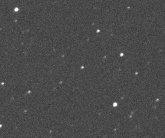
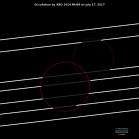
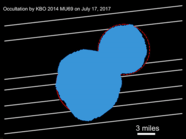
In June and July 2017, Arrokoth occulted three background stars.[87] The team behind New Horizons formed a specialized "KBO Chasers" team led by Marc Buie to observe these stellar occultations from South America, Africa, and the Pacific Ocean.[89][90][91] On 3 June 2017, two teams of NASA scientists tried to detect the shadow of Arrokoth from Argentina and South Africa.[92] When they found that none of their telescopes had observed the object's shadow, it was initially speculated that Arrokoth might be neither as large nor as dark as previously expected, and that it might be highly reflective or even a swarm.[92][93] Additional data taken with the Hubble Space Telescope in June and July 2017 revealed that the telescopes had been placed in the wrong location, and that these estimations were incorrect.[93]
On 10 July 2017, the airborne telescope SOFIA was successfully placed close to the predicted centerline for the second occultation while flying over the Pacific Ocean from Christchurch, New Zealand. The main purpose of those observations was the search for hazardous material like rings or dust near Arrokoth that could threaten the New Horizons spacecraft during its flyby in 2019. Data collection was successful. A preliminary analysis suggested that the central shadow was missed;[94] only in January 2018 was it realized that SOFIA had indeed observed a very brief dip from the central shadow.[95] The data collected by SOFIA will also be valuable to put constraints on dust near Arrokoth.[96][97] Detailed results of the search for hazardous material were presented on the 49th Meeting of the AAS Division for Planetary Sciences, on 20 October 2017.[98]
On 17 July 2017, the Hubble Space Telescope was used to check for debris around Arrokoth, setting constraints on rings and debris within the Hill sphere of Arrokoth at distances of up to 75,000 km (47,000 mi) from the main body.[99] For the third and final occultation, team members set up another ground-based "fence line" of 24 mobile telescopes along the predicted ground track of the occultation shadow in southern Argentina (Chubut and Santa Cruz provinces) to better constrain the size of Arrokoth.[90][91] The average spacing between these telescopes was around 4 km (2.5 mi).[100] Using the latest observations from Hubble, the position of Arrokoth was known with much better precision than for the 3 June occultation, and this time the shadow of Arrokoth was successfully observed by at least five of the mobile telescopes.[91] Combined with the SOFIA observations, this put constraints on possible debris near Arrokoth.[97]
Results from the occultation on 17 July showed that Arrokoth could have had a very oblong, irregular shape or be a close or contact binary.[100][44] According to the duration of the observed chords, Arrokoth was shown to have two "lobes", with diameters of approximately 20 km (12 mi) and 18 km (11 mi), respectively.[75] A preliminary analysis of all collected data suggested that Arrokoth was accompanied by an orbiting moonlet about 200–300 km (120–190 mi) away from the primary.[101] It was later realized, however, that an error with the data processing software resulted in a shift in the apparent location of the target. After accounting for the bug, the short dip observed on 10 July was considered to be a detection of the primary body.[95]
By combining data about its light curve,[74] spectra (e.g. color), and stellar occultation data,[100] illustrations could rely on known data to create a concept of what it might look like prior to spacecraft flyby.
2018 occultations
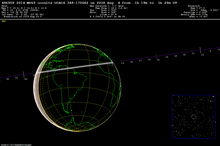
There were two potentially useful Arrokoth occultations predicted for 2018: one on 16 July and one on 4 August. Neither of these were as good as the three 2017 events.[87] No attempts were made to observe the 16 July 2018 occultation, which took place over the South Atlantic and the Indian Ocean. For the 4 August 2018 event, two teams, consisting of about 50 researchers in total, went to locations in Senegal and Colombia.[102] The event gathered media attention in Senegal, where it was used as an opportunity for science outreach.[103] Despite some stations being affected by bad weather, the event was successfully observed, as reported by the New Horizons team.[104] Initially, it was unclear whether a chord on the target had been recorded. On 6 September 2018, NASA confirmed that the star had indeed been seen to dip by at least one observer, providing important information about the size and shape of Arrokoth.[105]
Hubble observations were carried out on 4 August 2018, to support the occultation campaign.[106][102] Hubble could not be placed in the narrow path of the occultation, but due to the favourable location of Hubble at the time of the event, the space telescope was able to probe the region down to 1,600 km (990 mi) from Arrokoth. This is much closer than the 20,000 km (12,000 mi) region that could be observed during the 17 July 2017 occultation. No brightness changes of the target star have been seen by Hubble, ruling out any optically thick rings or debris down to 1,600 km (990 mi) from Arrokoth.[105] Results of the 2017 and 2018 occultation campaigns were presented at the 50th meeting of the American Astronomical Society Division for Planetary Sciences on 26 October 2018.[107]
Exploration
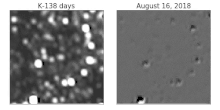
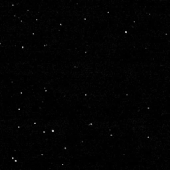
Having completed its flyby of Pluto in July 2015, the New Horizons spacecraft made four course changes in October and November 2015 to place itself on a trajectory towards Arrokoth.[109] It is the first object to be targeted for a flyby that was discovered after the visiting spacecraft was launched,[69][110] and is the farthest object in the Solar System ever to be visited by a spacecraft.[29][111][112] Moving at a speed of 51,500 km/h (858 km/min; 14.3 km/s)[113] New Horizons passed by Arrokoth at a distance of 3,538 km (2,198 mi), equivalent to a few minutes of travel at the craft's speed, and one third of the distance of the spacecraft's closest encounter with Pluto.[9] Closest approach occurred on 1 January 2019, at 05:33 UTC (Spacecraft Event Time – SCET)[101][114] at which point it was 43.4 AU from the Sun in the direction of the constellation Sagittarius.[115][116][117][68] At this distance, the one-way transit time for radio signals between Earth and New Horizons was 6 hours.[101]
The science objectives of the flyby include characterizing the geology and morphology of Arrokoth, mapping the surface composition (searching for ammonia, carbon monoxide, methane, and water ice). Surveys of the surrounding environment to detect possible orbiting moonlets, a coma, or rings, were conducted.[101] Images with resolutions showing details of 30 m (98 ft) to 70 m (230 ft) are expected.[101][118] From Hubble observations, faint, small satellites orbiting Arrokoth at distances greater than 2,000 km (1,200 mi) have been excluded to a depth of >29th magnitude.[74] The object has no detectable atmosphere, and no large rings or satellites larger than 1.6 km (1 mi) in diameter.[119] Nonetheless, a search for a related moon (or moons) continues, which may help better explain the formation of Arrokoth from two individual orbiting objects.[41]
New Horizons made its first detection of Arrokoth on 16 August 2018, from a distance of 172 million km (107 million mi).[120] At that time, Arrokoth was visible at magnitude 20, in the direction of the constellation Sagittarius.[121] Arrokoth was expected to be magnitude 18 by mid-November, and magnitude 15 by mid-December. It reached naked eye brightness (magnitude 6) from the spacecraft's point of view just 3–4 hours before closest approach.[108] If obstacles were detected, the spacecraft had the option of diverting to a more distant rendezvous, though no moons, rings or other hazards were seen.[101][121] High-resolution images from New Horizons were taken on 1 January. The first images of mediocre resolution arrived the next day.[122] The downlink of data collected from the flyby is expected to last 20 months, through to September 2020.[114]
Gallery
See also
| Wikimedia Commons has media related to 486958 Arrokoth. |
Notes
- Color MVIC image superimposed over a higher-resolution greyscale composite of nine 0.025 second exposures taken by the Long Range Reconnaissance Imager (LORRI) aboard New Horizons on 1 January 2019, from a distance of 6,628 kilometers (4,118 mi) at a resolution of 33 meters (108 ft) per pixel.[2] The contact binary object is made up of two lobes nicknamed "Ultima" (top) and "Thule" (bottom). Its axis of rotation is located near the bright "neck" of the object and spins clockwise from this viewpoint.[3]
- Pronounced /ˈærəkɒθ/
- Normally pronounced /ˈθjuːliː/ THEW-lee [US /ˈθuːliː/ THOO-lee].[20] The New Horizons team use this classical pronunciation, the pseudo-Latin pronunciation /ˈtuːleɪ/ TOO-lay, and the hybrid pronunciation /ˈtuːliː/ TOO-lee.[21][22]
- The only record of the word was collected in 1610–1611 by English writer William Strachey, who had a decent ear but bad handwriting, and scholars since have had considerable difficulty reading his notes. The meanings of the words are also often uncertain, as Strachey and the Powhatan had no language in common. Siebert (1975: p 324) used comparison with other Algonquian languages to interpret Strachey's handwriting, and deciphers Strachey's transcriptions as ⟨arrokoth⟩ 'sky' and ⟨arrahgwotuwss⟩ 'clouds'. He reconstructs these as the word /aːrahkwat/ 'cloud', pl. /aːrahkwatas/ (compare Ojibwa /aːnakkwat/ 'cloud'), from the Proto-Algonquian *aːlaxkwatwi 'it is a cloud, it is cloudy'.[25] Given that the first vowel is long (/aː/), that syllable would have been stressed in Powhatan, so the name is approximatable in English as ARR-o-koth.
- In the convention for minor planet provisional designations, the first letter represents the half-month of the year of discovery while the second letter and numbers indicate the order of discovery within that half-month. In the case for 2014 MU69, the first letter 'M' corresponds to the second half-month of June 2014 while the succeeding letter 'U' indicates that it is the 20th object discovered on the 70th cycle of discoveries (with 69 cycles completed). Each cycle consists of 25 letters representing discoveries, hence 20 + (69 cycles × 25 letters) = 1,745.[32]
- Composite of black and while and color photographs taken respectively by the LORRI and MVIC instruments aboard New Horizons on 1 January 2019.
- This discrepancy is due to limitations of the Minor Planet Center's standard satellite-based astrometry submission format, which by default, the JPL Small-Body Browser implements into its database of orbits. The Hubble Space Telescope is capable of producing highly accurate astrometric measurements of Arrokoth's position, though the data could not be submitted to the Minor Planet Center in the standard format. To overcome these limitations, the astrometric data was separately submitted in a modified format by the New Horizons team. While the Minor Planet Center includes these observations, the JPL Small-Body Database has not yet incorporated the data and only approximates the excess precision of previous astrometric measurements by Hubble in 2014, resulting in an inaccurately calculated orbit with unrealistic uncertainties.[69]
- Taken 6.5 minutes before closest approach at 5:33 UT. Note that the view and illumination is now from a slightly different angle as the spacecraft begins to bypass Arrokoth.
References
- Talbert, Tricia (16 May 2019). "NASA's New Horizons Team Publishes First Kuiper Belt Flyby Science Results". NASA. Retrieved 16 May 2019.
- "Spot On! New Horizons Spacecraft Returns Its Sharpest Views of Ultima Thule". pluto.jhuapl.edu. Applied Physics Laboratory. 22 February 2019. Archived from the original on 23 February 2019. Retrieved 23 February 2019.
...a resolution of about 110 feet (33 meters) per pixel. [...] This processed, composite picture combines nine individual images taken with the Long Range Reconnaissance Imager (LORRI), each with an exposure time of 0.025 seconds...
- "New Movie Shows Ultima Thule from an Approaching New Horizons". pluto.jhuapl.edu. Applied Physics Laboratory. 15 January 2019. Archived from the original on 16 January 2019. Retrieved 16 January 2019.
This movie shows the propeller-like rotation of Ultima Thule in the seven hours between 20:00 UT (3 p.m. ET) on Dec. 31, 2018, and 05:01 UT (12:01 a.m.) on Jan. 1, 2019...
- "JPL Small-Body Database Browser: 486958 Arrokoth (2014 MU69)" (2014-10-22 last obs.). Jet Propulsion Laboratory. Retrieved 15 March 2017.
- "(486958) Arrokoth = 2014 MU69". Minor Planet Center. International Astronomical Union. Retrieved 15 March 2017.
- Talbert, Tricia (13 March 2018). "New Horizons Chooses Nickname for 'Ultimate' Flyby Target". NASA. Retrieved 13 March 2018.
- Buie, Marc W. "Orbit Fit and Astrometric record for 486958". Southwest Research Institute. Retrieved 18 February 2018.
- "MPC -- Orbit Sketch". Minor Planet Center. International Astronomical Union. Retrieved 2 February 2020.
- Spencer, J. R.; Stern, S. A.; Moore, J. M.; Weaver, H. A.; Singer, K. N.; Olkin, C. B.; et al. (13 February 2020). "The geology and geophysics of Kuiper Belt object (486958) Arrokoth". Science. 367 (6481). arXiv:2004.00727. doi:10.1126/science.aay3999. ISSN 1095-9203. PMID 32054694. aay3999.
- McKinnon, W. B.; Richardson, D. C.; Marohnic, J. C.; Keane, J. T.; Grundy, W. M.; Hamilton, D. P.; et al. (13 February 2020). "The solar nebula origin of (486958) Arrokoth, a primordial contact binary in the Kuiper Belt". Science. 367 (6481). arXiv:2003.05576. doi:10.1126/science.aay3999. ISSN 1095-9203. PMID 32054695. aay6620. Archived from the original on 13 February 2020.
- "Press Briefing: The developing picture of Ultima Thule". YouTube. Lunar and Planetary Institute. 21 March 2019.
- Buie, Marc W.; Porter, Simon B.; Tamblyn, Peter; Terrell, Dirk; Parker, Alex H.; Baratoux, David; et al. (January 2020). "Size and Shape Constraints of (486958) Arrokoth from Stellar Occultations". The Astronomical Journal. 159 (4): 130. arXiv:2001.00125. doi:10.3847/1538-3881/ab6ced.
- Porter, Simon B.; Beyer, Ross A.; Keane, James T.; Umurhan, Orkan M.; Bierson, Carver J.; Grundy, William M.; et al. (September 2019). The Shape and Pole of (486958) 2014 MU69 (PDF). EPSC-DPS Joint Meeting 2019. 13. European Planetary Science Congress.
- Hofgartner, Jason D.; Buratti, Bonnie J.; Benecchi, Susan D.; Beyer, Ross A.; Cheng, Andrew; keane, James T.; et al. (3 March 2020). "Photometry of Kuiper Belt Object (486958) Arrokoth from New Horizons LORRI". Icarus: 113723. arXiv:2003.01224. doi:10.1016/j.icarus.2020.113723.
- Benecchi, S. D.; Borncamp, D.; Parker, A. H.; Buie, M. W.; Noll, K. S.; Binzel, R. P.; et al. (December 2019). "The color and binarity of (486958) 2014 MU69 and other long-range New Horizons Kuiper Belt targets". Icarus. 334: 22–29. arXiv:1812.04752. doi:10.1016/j.icarus.2019.01.025.
- Thirouin, Audrey; Sheppard, Scott S. (August 2019). "Colors of Trans-Neptunian Contact Binaries". The Astronomical Journal. 158 (2): 53. arXiv:1906.02071. Bibcode:2019AJ....158...53T. doi:10.3847/1538-3881/ab27bc.
- "New Horizons Successfully Explores Ultima Thule". pluto.jhuapl.edu. Applied Physics Laboratory. 1 January 2019. Archived from the original on 1 January 2019. Retrieved 1 January 2019.
- "About Arrokoth". pluto.jhuapl.edu. Applied Physics Laboratory. Archived from the original on 6 November 2019.
- Porter, S. B.; Bierson, C. J.; Umurhan, O.; Beyer, R. A.; Lauer, T. A.; Buie, M. W.; et al. (March 2019). A Contact Binary in the Kuiper Belt: The Shape and Pole of (486958) 2014 MU69 (PDF). 50th Lunar and Planetary Science Conference 2019. Lunar and Planetary Institute. Bibcode:2019LPI....50.1611P.
- "Thule". Oxford English Dictionary second edition. Oxford University Press. 1989. Retrieved 7 December 2018.
- "New Horizons Press Kit" (PDF). Applied Physics Laboratory. December 2018. p. 5. Retrieved 1 January 2019.
- "New Horizons: First Images of Ultima Thule". YouTube. Applied Physics Laboratory. 1 January 2019.
- Lauer, Tod R.; Throop, Henry (17 January 2019). "The Moment We First Saw Ultima Thule Up Close". Scientific American. Springer Nature. Retrieved 26 January 2019.
- "New Horizons Kuiper Belt Flyby Object Officially Named 'Arrokoth'". pluto.jhuapl.edu. Applied Physics Laboratory. 12 November 2019. Retrieved 12 November 2019.
- Siebert, Frank (1975). "Resurrecting Virginia Algonquian from the dead: The reconstituted and historical phonology of Powhatan". In Crawford, James (ed.). Studies in Southeastern Indian Languages. University of Georgia Press. pp. 285–453.
- "M.P.C. 118222" (PDF). Minor Planet Center. Astronomical International Union. 8 November 2019.
- "Hubble Survey Finds Two Kuiper Belt Objects to Support New Horizons Mission". HubbleSite. Space Telescope Science Institute. 1 July 2014.
- Buie, Marc W. (15 October 2014). "New Horizons HST KBO Search Results: Status Report" (PDF). Space Telescope Science Institute. p. 23.
- Talbert, Tricia (28 August 2015). "NASA's New Horizons Team Selects Potential Kuiper Belt Flyby Target". NASA. Retrieved 4 September 2015.
- "NASA's Hubble Telescope Finds Potential Kuiper Belt Targets for New Horizons Pluto Mission". HubbleSite. Space Telescope Science Institute. 15 October 2014.
- Wall, Mike (15 October 2014). "Hubble Telescope Spots Post-Pluto Targets for New Horizons Probe". Space.com. Archived from the original on 15 October 2014.
- "New- And Old-Style Minor Planet Designations". Minor Planet Center. International Astronomical Union. Retrieved 17 May 2019.
- "M.P.C. 103886" (PDF). Minor Planet Center. Astronomical International Union. 12 March 2017.
- Talbert, Tricia (6 November 2017). "Help Nickname New Horizons' Next Flyby Target". NASA.
NASA's New Horizons mission to Pluto and the Kuiper Belt is looking for your ideas on what to informally name its next flyby destination, a billion miles (1.6 billion kilometers) past Pluto.
- Wall, Mike (14 March 2018). "New Horizons, Meet Ultima Thule: Probe's Next Target Gets a Nickname". Space.com.
- Herrero, Nieves; Roseman, Sharon R. (2015). The Tourism Imaginary and Pilgrimages to the Edges of the World. Channel View Publications. p. 122. ISBN 9781845415235.
- Gebhardt, Chris (2 January 2019). "2014 MU69 revealed as a contact binary in first New Horizons data returns". NASASpaceFlight.com. Retrieved 5 January 2019.
- Deborah Byrd (13 November 2019). "Ultima Thule renamed to avoid Nazi link". EarthSky.
- "Thule Culture". Museum of the North. University of Alaska. 29 April 2016. Retrieved 13 November 2019.
- Bartels, Meghan (14 March 2018). "NASA named its next New Horizons target Ultima Thule, a mythical land with a Nazi connection". Newsweek. Retrieved 2 January 2019.
- Wall, Mike (4 January 2019). "The Hunt Is On for Moons Around Ultima Thule". Space.com. Retrieved 4 January 2019.
- Stern, S. A.; Weaver, H. A.; Spencer, J. R.; Olkin, C. B.; Gladstone, G. R.; Grundy, W. M.; Moore, J. M.; Cruikshank, D. P.; Elliott, H. A.; McKinnon, W. B.; et al. (17 May 2019). "Initial results from the New Horizons exploration of 2014 MU69, a small Kuiper Belt object". Science. 364 (6441). arXiv:2004.01017. Bibcode:2019Sci...364.9771S. doi:10.1126/science.aaw9771. PMID 31097641. aaw9771.
- Spencer, John R.; Moore, Jeffrey M.; McKinnon, William B.; Stern, S. Alan; Weaver, Harold A.; Olkin, Catherine B.; et al. (September 2019). Geology and Geophysics of 2014 MU69: New Horizons Flyby Results (PDF). EPSC-DPS Joint Meeting 2019. 13. European Planetary Science Congress.
- Keeter, Bill (3 August 2017). "New Horizons' Next Target Just Got a Lot More Interesting". NASA.
- Chang, Kenneth (3 January 2019). "What We've Learned About Ultima Thule From NASA's New Horizons Mission". The New York Times. Retrieved 4 January 2019.
- Keeter, Bill (8 February 2019). "New Horizons' Evocative Farewell Glance at Ultima Thule". NASA. Retrieved 9 February 2019.
- "Exploring Ultima Thule: humanity's next frontier". YouTube. SETI Institute. 19 March 2019. Retrieved 23 March 2019.
- Grossman, Lisa (18 March 2019). "Ultima Thule may be a frankenworld". Science News. Society for Science & the Public. Retrieved 23 March 2019.
- Chang, Kenneth (18 March 2019). "How Ultima Thule Is Like a Sticky, Pull-Apart Pastry". The New York Times. Retrieved 19 March 2019.
- Grundy, W. M.; Bird, M. K.; Britt, D. T.; Cook, J. C.; Cruikshank, D. P.; Howett, C. J. A.; et al. (13 February 2020). "Color, composition, and thermal environment of Kuiper Belt object (486958) Arrokoth". Science. 367 (6481). arXiv:2002.06720. doi:10.1126/science.aay3705. ISSN 1095-9203. PMID 32054693. aay3705.
- Lyra, Wladmir; Youdin, Andrew N.; Johansen, Anders (2 March 2020). "Evolution of MU69 from a binary planetesimal into contact by Kozai-Lidov oscillations and nebular drag". arXiv:2003.00670 [astro-ph.EP].
- Talbert, Tricia (18 October 2016). "New Horizons: Possible Clouds on Pluto, Next Target is Reddish". NASA. Retrieved 17 November 2019.
- "A Prehistoric Puzzle in the Kuiper Belt". pluto.jhuapl.edu. Applied Physics Laboratory. 18 March 2019. Archived from the original on 26 March 2019. Retrieved 18 March 2019.
- Jewitt, David C.; et al. (13 February 2020). "A deep dive into the abyss". Science. 367 (6481): 980–981. doi:10.1126/science.aba6889. ISSN 1095-9203. PMID 32054696. eaba6889.
- Cruikshank, D. P.; Grundy, W. M.; Britt, D. T.; Quirico, E.; Schmitt, B.; Scipioni, F.; et al. (1 January 2019). The colors of 486958 2014 MU69 ("Ultima Thule"): The role of synthetic organic solids (tholins) (PDF). 50th Lunar and Planetary Science Conference. Lunar and Planetary Institute.
- Singer, Kelsi N.; McKinnon, William B.; Spencer, John R.; Greenstreet, Sarah; Gladman, Brett; Robbins, Stuart J.; et al. (September 2019). Impact craters on 2014 MU69: The geologic history of MU69 and Kuiper belt object size-frequency distributions (PDF). EPSC-DPS Joint Meeting 2019. 13. European Planetary Science Congress.
- Greenstreet, Sarah; Gladman, Brett; McKinnon, William B.; Kavelaars, J. J.; Singer, Kelsi N. (February 2019). "Crater Density Predictions for New Horizons flyby target 2014 MU69". The Astrophysical Journal Letters. 872 (1): 6. arXiv:1812.09785. Bibcode:2019ApJ...872L...5G. doi:10.3847/2041-8213/ab01db. L5.
- "New Horizons' Newest and Best-Yet View of Ultima Thule". NASA Solar System Exploration. NASA. 24 January 2019. Retrieved 17 March 2019.
- Moore, J. M.; McKinnon, W. B.; Spencer, J. R.; Stern, S. A.; Britt, D.; Buratti, B. J.; et al. (September 2019). Scarp Retreat on MU69: Evidence and Implications for Composition and Structure (PDF). EPSC-DPS Joint Meeting 2019. 13. European Planetary Science Congress.
- Grossman, Lisa (29 January 2019). "The latest picture of Ultima Thule reveals a remarkably smooth face". Science News. Society for Science & the Public. Retrieved 17 March 2019.
- Beatty, Kelly (4 January 2019). "New Views of Two-Lobed "Ultima Thule"". Sky & Telescope. Retrieved 22 February 2019.
- Stern, S. A.; Spencer, J. R.; Weaver, H. A.; Olkin, C. B.; Moore, J. M.; Grundy, W.; et al. (9 January 2019). Overview of initial results from the reconnaissance flyby of a Kuiper Belt planetesimal: 2014 MU69 (PDF). 50th Lunar and Planetary Science Conference 2019. Lunar and Planetary Institute. arXiv:1901.02578. Bibcode:2019LPI....50.1742S.
- Katz, J. I. (4 February 2019). "Ultima Thule (486958; 2014 MU69): Necklace, Composition, Rotation, Formation". arXiv:1902.00997 [astro-ph.EP].
- Earle, Alissa M.; Binzel, R. P.; Keane, J. T.; Vanatta, M.; Grundy, W. M.; Moore, J. M.; et al. (September 2019). Latitude Zones and Seasons on 2014 MU69 'Ultima Thule' (PDF). EPSC-DPS Joint Meeting 2019. 13. European Planetary Science Congress.
- Prentice, Andrew J. R. (9 January 2019). "Ultima Thule: a Prediction for the Origin, Bulk Chemical Composition, and Physical Structure, submitted prior to the New Horizons Spacecraft 100 Pixel LORRI Data Return". arXiv:1901.02850 [astro-ph.EP].
- "Minor Planet Ephemeris Service: Query Results". Minor Planet & Comet Ephemeris Service (Settings: "Return ephemerides", Ephemeris Options: start date "2018/12/31" and output dates "365"). Minor Planet Center. Retrieved 4 February 2020.
- Davis, Jason (19 September 2018). "'Everything about this flyby is tougher': New Horizons just over 100 days from Ultima Thule". The Planetary Society. Retrieved 4 February 2020.
- "KBO 2014 MU69 (Ultima Thule)". The Sky Live. Archived from the original on 5 February 2020. Retrieved 5 February 2020.
- Lakdawalla, Emily (1 September 2015). "New Horizons extended mission target selected". The Planetary Society.
- Delsanti, Audrey; Jewitt, David (2006). "The Solar System Beyond The Planets" (PDF). In Blonde, P.; Mason, J. (eds.). Solar System Update. Springer. pp. 267–293. Bibcode:2006ssu..book..267D. doi:10.1007/3-540-37683-6_11. ISBN 3-540-26056-0. Archived from the original (PDF) on 25 September 2007.
- Porter, S. B.; Parker, A. H.; Buie, M.; Spencer, J.; Weaver, H.; Stern, S. A.; et al. (March 2015). Orbits and Accessibility of Potential New Horizons KBO Encounter Targets (PDF). 46th Lunar and Planetary Science Conference. Lunar and Planetary Institute. Bibcode:2015LPI....46.1301P.
- "List Of Trans-Neptunian Objects". Minor Planet Center. International Astronomical Union. Retrieved 4 February 2020.
- Lakdawalla, Emily (15 October 2014). "Finally! New Horizons has a second target". The Planetary Society. Archived from the original on 15 October 2014.
- Benecchi, Susan D.; Buie, Marc W.; Porter, Simon Bernard; Spencer, John R.; Verbiscer, Anne J.; Stern, S. Alan; Zangari, Amanda Marie; Parker, Alex; Noll, Keith S. (December 2019). "The HST Lightcurve of (486958) 2014 MU69". Icarus. 334: 11–21. arXiv:1812.04758. Bibcode:2017DPS....4950407B. doi:10.1016/j.icarus.2019.01.023.
- Stern, Alan (8 August 2017). "The PI's Perspective: The Heroes of the DSN and the 'Summer of MU69'". Applied Physics Laboratory. Retrieved 8 August 2017.
- "Ultima Thule's First Mystery". pluto.jhuapl.edu. Applied Physics Laboratory. 20 December 2018. Archived from the original on 1 January 2019. Retrieved 27 December 2018.
- "Arrokoth (2014 MU69) – In Depth". NASA Solar System Exploration. NASA. 19 December 2019. Retrieved 2 February 2020.
- Beatty, Kelly (19 March 2019). "New Results Probe the Origin of "Ultima Thule"". Sky & Telescope. Retrieved 19 March 2019.
- McKinnon, William B.; Keane, James T.; Nesvorný, David; Richardson, Derek R.; Grundy, William M.; Hamilton, Douglas P.; et al. (September 2019). On the Origin of the Remarkable Contact Binary (486958) 2014 MU69 ("Ultima Thule") (PDF). EPSC-DPS Joint Meeting 2019. 13. European Planetary Science Congress.
- Bartels, Meghan (18 March 2019). "NASA's New Horizons Reveals Geologic 'Frankenstein' That Formed Ultima Thule". Space.com. Retrieved 18 March 2019.
- Mao, Xiaochen; McKinnon, William B.; Keane, James Tuttle; Spencer, John R.; Olkin, Catherine; Weaver, Harold A.; Stern, S. Alan (11 December 2019). Spindown of 2014 MU69 ("Ultima Thule") by impact of small, cold classical Kuiper belt objects. AGU Fall Meeting 2019. American Geophysical Union. Retrieved 1 December 2019.
- Lakdawalla, Emily (17 June 2014). "Hubble to the rescue! The last-ditch effort to discover a Kuiper belt target for New Horizons". The Planetary Society.
- Witze, Alexandra (22 May 2014). "Pluto-bound probe faces crisis". 509 (7501). Nature. pp. 407–408. doi:10.1038/509407a.
- Parker, Alex (28 June 2016). "A World Beyond Pluto: Finding a New Target for New Horizons". blogs.nasa.gov. NASA.
- Spencer, J. R.; Buie, M. W.; Parker, A. H.; Weaver, H. A.; Porter, S. B.; Stern, S. A.; et al. (2015). The Successful Search for a Post-Pluto KBO Flyby Target for New Horizons Using the Hubble Space Telescope (PDF). European Planetary Science Congress 2015. 10. Bibcode:2015EPSC...10..417S.
- Stern, S. A.; Weaver, H. A.; Spencer, J. A.; Elliott, H. A.; et al. (June 2018). "The New Horizons Kuiper Belt Extended Mission". Space Science Reviews. Springer Link. 214 (4): 23. arXiv:1806.08393. Bibcode:2018SSRv..214...77S. doi:10.1007/s11214-018-0507-4. 77.
- Young, Eliot (2016). "Mission Support of the New Horizons 2014 MU69 Encounter via Stellar Occultations". SOFIA Proposal. 5: 168. Bibcode:2016sofi.prop..168Y. Retrieved 27 July 2017.
- Anderson, Paul Scott (8 August 2018). "New Horizons team successfully observes new stellar occultation of Ultima Thule". Planetaria. Retrieved 15 January 2019.
- "These are the 2017 stellar occultation predictions for the object 2014 MU69". Southwest Research Institute. Retrieved 27 July 2017.
- "KBO Chasers". pluto.jhuapl.edu. Applied Physics Laboratory. Archived from the original on 28 July 2017.
- "NASA's New Horizons Team Strikes Gold in Argentina". pluto.jhuapl.edu. Applied Physics Laboratory. 19 July 2017. Archived from the original on 20 July 2017.
- Talbert, Tricia (5 July 2017). "New Mysteries Surround New Horizons' Next Flyby Target". NASA.
- "The Case of the Dog that Didn't Bark in the Night". The Outer Sanctum. 7 July 2017. Archived from the original on 9 July 2017.
- Chang, Kenneth (8 August 2017). "Chasing Shadows for a Glimpse of a Tiny World Beyond Pluto". The New York Times. Retrieved 9 August 2017.
- Lakdawalla, Emily (24 January 2018). "New Horizons prepares for encounter with 2014 MU69". The Planetary Society. Retrieved 25 January 2018.
- "SOFIA to Make Advance Observations of Next New Horizons Flyby Object". pluto.jhuapl.edu. Applied Physics Laboratory. 10 July 2017. Archived from the original on 13 July 2019.
- "SOFIA in Right Place at Right Time to Study Next New Horizons Flyby Object". pluto.jhuapl.edu. Applied Physics Laboratory. 11 July 2017. Archived from the original on 14 July 2017. Retrieved 28 July 2017.
- Young, Eliot F.; Buie, Marc W.; Porter, Simon B.; Zangari, Amanda M.; Stern, S. Alan; Ennico, Kimberly; et al. (October 2017). Debris search around (486958) 2014 MU69: Results from SOFIA and ground-based occultation campaigns. 49th Meeting of the AAS Division for Planetary Sciences. American Astronomical Society. Bibcode:2017DPS....4950406Y. 504.06. Archived from the original on 9 October 2018. Retrieved 20 July 2019.
- Kammer, Joshua A.; Becker, Tracy M.; Retherford, Kurt D.; Stern, S. Alan; Olkin, Catherine B.; Buie, Marc W.; et al. (27 July 2018). "Probing the Hill Sphere of (486958) 2014 MU69: HST FGS Observations during the 2017 July 17 Stellar Occultation". The Astronomical Journal. American Astronomical Society. 156 (2): 72. arXiv:1806.09684. Bibcode:2018AJ....156...72K. doi:10.3847/1538-3881/aacdf8.
- Buie, M. W.; Porter, S. B.; Tamblyn, P.; Terrell, D.; Verbiscer, A. J.; Keeney, B.; et al. (March 2019). Stellar Occultation Results for (486958) 2014 MU69: A Pathfinding Effort for the New Horizons Flyby (PDF). 50th Lunar and Planetary Science Conference 2019. Lunar and Planetary Institute. Retrieved 27 July 2017.
- Green, Jim; Stern, S. Alan (12 December 2017). New Horizons Kuiper Belt Extended Mission (PDF). 2017 AGU Fall Meeting. Applied Physics Laboratory. pp. 12–15. Archived from the original (PDF) on 26 December 2018. Retrieved 26 December 2018.
- "New Horizons team prepares for stellar occultation ahead of Ultima Thule flyby". Space Daily. 2 August 2018. Retrieved 2 August 2018.
- "AFIPS participation to NASA expedition in Senegal". Africa Initiative for Planetary and Space Sciences. 2018. Retrieved 21 August 2018.
- "New Horizons Team Reports Initial Success in Observing Ultima Thule". pluto.jhuapl.edu. Applied Physics Laboratory. 4 August 2018. Archived from the original on 4 August 2018. Retrieved 21 August 2018.
- Keeter, Bill (6 September 2018). "New Horizons Team Successfully Observes Next Target, Sets the Stage for Ultima Thule Flyby". NASA. Retrieved 21 September 2018.
- Buie, Marc W. (9 February 2018). "New Horizons support observations for 2014MU69 encounter – HST Proposal 15450". Mikulski Archive for Space Telescope. Space Telescope Science Institute. Retrieved 9 March 2018.
- Buie, Marc; Porter, Simon B.; Verbiscer, Anne; Leiva, Rodrigo; Keeney, Brian A.; Tsang, Con; Baratoux, David; Skrutskie, Michael; Colas, François; Desmars, Josselin; Stern, S. Alan (26 October 2018). Pre-encounter update on (486958) 2014MU69 and occultation results from 2017 and 2018. 50th Meeting of the AAS Division for Planetary Sciences. American Astronomical Society. Bibcode:2018DPS....5050906B. 509.06.
- "HORIZONS Web-Interface". Jet Propulsion Laboratory. Retrieved 20 June 2019.
- "NASA's New Horizons Completes Record-Setting Kuiper Belt Targeting Maneuvers". pluto.jhuapl.edu. Applied Physics Laboratory. 5 November 2015. Archived from the original on 7 November 2015. Retrieved 6 November 2015.
- "The Journey Continued – Exactly Five Years Ago, the New Horizons Team Discovered 2014 MU69 – and Prepared to Make the Distant Kuiper Belt Object Part of Space Exploration History". pluto.jhuapl.edu. Applied Physics Laboratory. 26 June 2019.
- Chang, Kenneth (31 December 2018). "NASA's New Horizons Will Visit Ultima Thule on New Year's Day". The New York Times. Retrieved 31 December 2018.
- Chang, Kenneth (30 December 2018). "A Journey Into the Solar System's Outer Reaches, Seeking New Worlds to Explore". The New York Times. Retrieved 30 December 2018.
- Stern, Allan (26 December 2018). "New Horizons: Ultima Thule is dead ahead". Sky and Telescope.
- Lakdawalla, Emily (17 December 2018). "What to Expect When New Horizons Visits 2014 MU69, Ultima Thule, And When We Will Get Pictures". The Planetary Society. Retrieved 27 December 2018.
- "Maneuver Moves New Horizons Spacecraft toward Next Potential Target". pluto.jhuapl.edu. Applied Physics Laboratory. 23 October 2015. Archived from the original on 25 October 2015. Retrieved 5 November 2015.
- "New Horizons Continues Toward Potential Kuiper Belt Target". pluto.jhuapl.edu. Applied Physics Laboratory. 26 October 2015. Archived from the original on 19 November 2015. Retrieved 5 November 2015.
- "On Track: New Horizons Carries Out Third KBO Targeting Maneuver". pluto.jhuapl.edu. Applied Physics Laboratory. 29 October 2015. Archived from the original on 1 November 2015. Retrieved 5 November 2015.
- "New Horizons Files Flight Plan for 2019 Flyby". pluto.jhuapl.edu. Applied Physics Laboratory. 6 September 2017. Archived from the original on 7 September 2017.
- "Ultima Thule: Preliminary Science Results from New Horizons". Sci-News.com. 4 January 2019. Retrieved 5 January 2019.
- "Ultima in View: New Horizons Makes First Detection of Kuiper Belt Flyby Target". pluto.jhuapl.edu. Applied Physics Laboratory. 28 August 2018. Archived from the original on 29 August 2017. Retrieved 3 September 2018.
- "NASA's New Horizons Spacecraft Takes the Inside Course to Ultima Thule". pluto.jhuapl.edu. Applied Physics Laboratory. 18 December 2018. Archived from the original on 28 December 2018.
- Chang, Kenneth (2 January 2019). "NASA's New Horizons Mission Releases Snowman-like Picture of Ultima Thule". The New York Times. Retrieved 2 January 2019.
- "LORRI Images from the Arrokoth Flyby". pluto.jhuapl.edu. Applied Physics Laboratory. Retrieved 2 February 2020.
External links
| Wikimedia Commons has media related to 486958 Arrokoth. |
- Arrokoth (2014 MU69): Most Distant Object Explored Up Close at NASA Solar System Exploration
- About Arrokoth (2014 MU69)
- LORRI Images from the Arrokoth Flyby
- 486958 Arrokoth at AstDyS-2, Asteroids—Dynamic Site
- 486958 Arrokoth at the JPL Small-Body Database

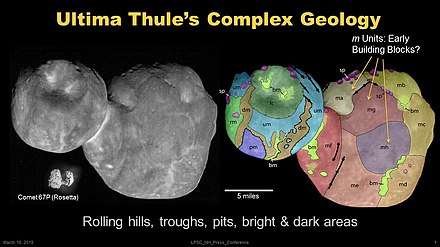
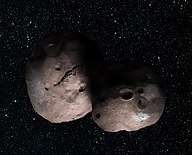
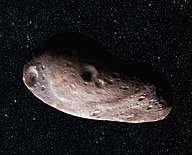
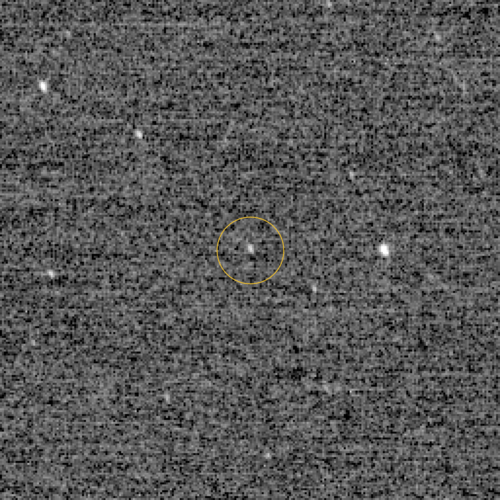
.png)
.png)
.png)
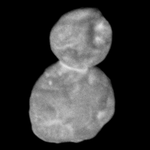
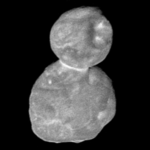
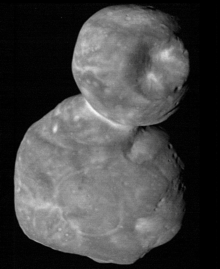
.png)
